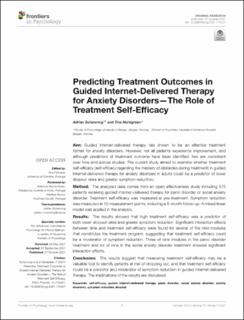| dc.contributor.author | Schønning, Adrian | |
| dc.contributor.author | Nordgreen, Tine | |
| dc.date.accessioned | 2022-04-21T12:11:07Z | |
| dc.date.available | 2022-04-21T12:11:07Z | |
| dc.date.created | 2021-11-22T22:26:47Z | |
| dc.date.issued | 2021 | |
| dc.identifier.issn | 1664-1078 | |
| dc.identifier.uri | https://hdl.handle.net/11250/2992006 | |
| dc.description.abstract | Aim: Guided Internet-delivered therapy has shown to be an effective treatment format for anxiety disorders. However, not all patients experience improvement, and although predictors of treatment outcome have been identified, few are consistent over time and across studies. The current study aimed to examine whether treatment self-efficacy (self-efficacy regarding the mastery of obstacles during treatment) in guided Internet-delivered therapy for anxiety disorders in adults could be a predictor of lower dropout rates and greater symptom reduction.
Method: The analyzed data comes from an open effectiveness study including 575 patients receiving guided Internet-delivered therapy for panic disorder or social anxiety disorder. Treatment self-efficacy was measured at pre-treatment. Symptom reduction was measured at 10 measurement points, including a 6-month follow-up. A mixed linear model was applied in the analysis.
Results: The results showed that high treatment self-efficacy was a predictor of both lower dropout rates and greater symptom reduction. Significant interaction effects between time and treatment self-efficacy were found for several of the nine modules that constitutes the treatment program, suggesting that treatment self-efficacy could be a moderator of symptom reduction. Three of nine modules in the panic disorder treatment and six of nine in the social anxiety disorder treatment showed significant interaction effects.
Conclusion: The results suggest that measuring treatment self-efficacy may be a valuable tool to identify patients at risk of dropping out, and that treatment self-efficacy could be a predictor and moderator of symptom reduction in guided Internet-delivered therapy. The implications of the results are discussed. | en_US |
| dc.language.iso | eng | en_US |
| dc.publisher | Frontiers | en_US |
| dc.rights | Navngivelse 4.0 Internasjonal | * |
| dc.rights.uri | http://creativecommons.org/licenses/by/4.0/deed.no | * |
| dc.title | Predicting Treatment Outcomes in Guided Internet-Delivered Therapy for Anxiety Disorders—The Role of Treatment Self-Efficacy | en_US |
| dc.type | Journal article | en_US |
| dc.type | Peer reviewed | en_US |
| dc.description.version | publishedVersion | en_US |
| dc.rights.holder | Copyright 2021 The Author(s) | en_US |
| dc.source.articlenumber | 712421 | en_US |
| cristin.ispublished | true | |
| cristin.fulltext | original | |
| cristin.qualitycode | 1 | |
| dc.identifier.doi | 10.3389/fpsyg.2021.712421 | |
| dc.identifier.cristin | 1957524 | |
| dc.source.journal | Frontiers in Psychology | en_US |
| dc.relation.project | Norges forskningsråd: 309264 | en_US |
| dc.identifier.citation | Frontiers in Psychology. 2021, 12, 712421. | en_US |
| dc.source.volume | 12 | en_US |

